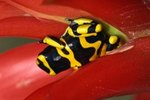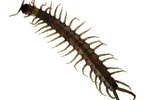
Black mambas (Dendroaspis polylepis) are speedy snakes that are extremely toxic. When they're in fearful situations, they often behave in ferocious manners. They inhabit sub-Saharan parts of Africa, specifically nations such as Ethiopia, Uganda and Namibia. When they breed, they do indeed abandon their eggs. Black mambas do not monitor their progress.
Breeding Season
Mating for black mambas take place at the start of the spring each year. Male specimens track down females through pursuing smells. They often undergo lengthy journeys to get to them. Once the males locate the whereabouts of their potential mating partners, they carefully examine them by flipping their tongues all over their physiques. Mating acts in black mambas are rather extended in duration. Once mating is complete, the males and females promptly part ways. The males do not participate in caring for the offspring in any way.
Depositing the Eggs
It takes female black mambas a few weeks to deposit their eggs post-mating. They deposit between six and 17 of them in total. When the mothers seek out appropriate sites to lay their eggs, they often opt for rotting plants. These plants emit heat, which provides warmth and therefore helps the eggs hatch more quickly. The mothers also frequently lay their eggs inside of termite mounds or holes that were carved out by other animals. The goal for the eggs is to stay both damp and warm. Oxygen and water are both necessary components for the maturation of the eggs. The shells permit both oxygen and H20 to travel to the unborn youngsters.
Abandoning the Babies
After the mothers deposit their eggs in sites of their choosing, they abandon them. It takes approximately six weeks for the offspring to emerge from their eggs. When they do, they're immediately responsible for taking care of their own well-being. The mothers are already well out of the picture. This abandonment practice isn't at all uncommon in the snake world.
Newborn Black Mambas
Newborn black mambas are usually approximately 20 inches in length. When they're adults, they can grow to a maximum of 14 feet long. The hatchlings are usually greenish-gray or pale green. Mature specimens are typically yellowish-green or gray. The "black" component of their naming refers to their mouth interior coloration. Black mambas are capable of seizing some prey as soon as they're born. When they get to roughly 12 months old, they're generally about 6 feet in length. Like adults, the newborns are venomous. Mongooses, jackals and big frogs are all typical predators of youthful black mambas.
References
- National Geographic: Black Mamba
- The IUCN Red List of Threatened Species: Dendroaspis Polylepis
- Young People's Trust for the Environment: Snake (Black Mamba)
- PBS Nature: Black Mamba - Introduction
- Black Mambas; Adam G. Klein
- Tropical Forest Biomes; Barbara A. Holzman
- Snakes; Harry W. Greene
- University of Michigan Animal Diversity Web: Dendroaspis Polylepsis
- Snakes and Other Reptiles; Andrew Solway
Photo Credits
-
Anup Shah/Digital Vision/Getty Images




